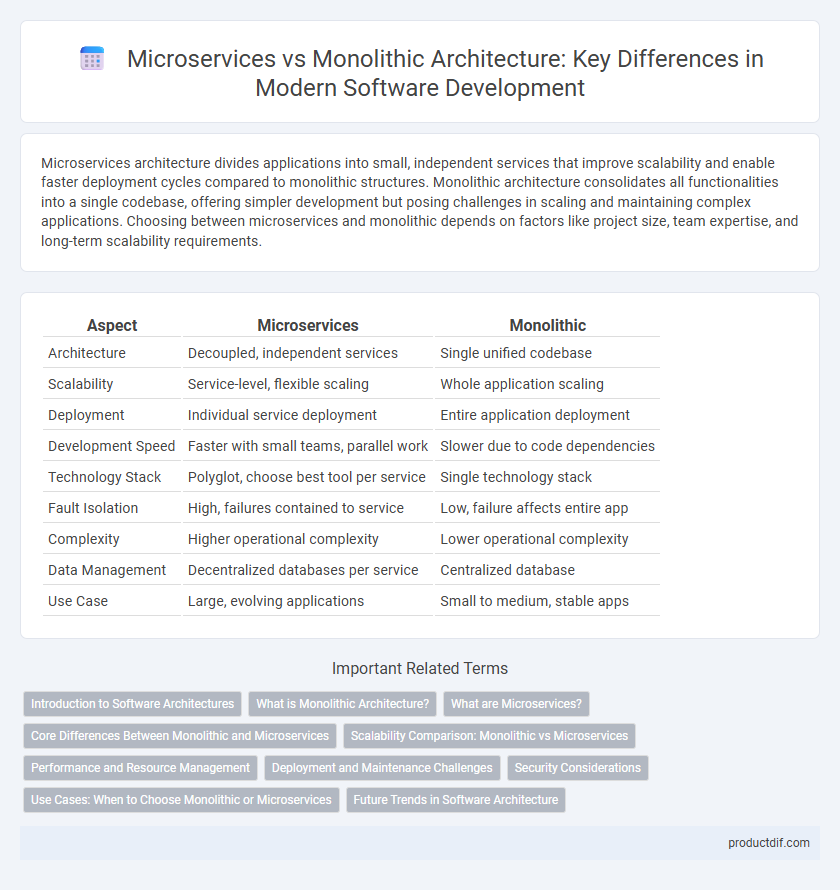Microservices architecture divides applications into small, independent services that improve scalability and enable faster deployment cycles compared to monolithic structures. Monolithic architecture consolidates all functionalities into a single codebase, offering simpler development but posing challenges in scaling and maintaining complex applications. Choosing between microservices and monolithic depends on factors like project size, team expertise, and long-term scalability requirements.
Table of Comparison
| Aspect | Microservices | Monolithic |
|---|---|---|
| Architecture | Decoupled, independent services | Single unified codebase |
| Scalability | Service-level, flexible scaling | Whole application scaling |
| Deployment | Individual service deployment | Entire application deployment |
| Development Speed | Faster with small teams, parallel work | Slower due to code dependencies |
| Technology Stack | Polyglot, choose best tool per service | Single technology stack |
| Fault Isolation | High, failures contained to service | Low, failure affects entire app |
| Complexity | Higher operational complexity | Lower operational complexity |
| Data Management | Decentralized databases per service | Centralized database |
| Use Case | Large, evolving applications | Small to medium, stable apps |
Introduction to Software Architectures
Microservices architecture splits applications into independent, loosely coupled services, enhancing scalability and flexibility, while monolithic architecture combines all components into a single, unified codebase for simplicity and easier deployment. Choosing between microservices and monolithic depends on project complexity, team size, and scalability requirements. Understanding software architecture principles is critical for optimizing performance, maintainability, and development speed in modern application design.
What is Monolithic Architecture?
Monolithic architecture is a traditional software design where all components and functions are tightly integrated into a single codebase, creating a unified application. This design simplifies development and deployment but often leads to scalability challenges and limited flexibility, as changes in one part require rebuilding and redeploying the entire system. Monolithic systems can face maintenance difficulties and slower release cycles compared to microservices, especially as application size and complexity grow.
What are Microservices?
Microservices are an architectural style that structures an application as a collection of small, independently deployable services, each running a unique process and communicating through APIs. This design promotes scalability, flexibility, and faster development cycles compared to monolithic architecture. Each microservice is focused on a specific business capability, enabling teams to develop, deploy, and maintain components autonomously.
Core Differences Between Monolithic and Microservices
Monolithic architecture consolidates all software components into a single unified codebase, leading to simpler deployment but limited scalability and slower updates. Microservices architecture decomposes applications into loosely coupled, independently deployable services, enhancing scalability, fault isolation, and continuous delivery. Core differences include modularity, deployment complexity, and the ability to evolve parts of the system independently, impacting development speed and system resilience.
Scalability Comparison: Monolithic vs Microservices
Microservices architecture excels in scalability by allowing independent services to be deployed, scaled, and updated without impacting the entire system, optimizing resource utilization. In contrast, monolithic applications face scalability challenges due to their tightly coupled components, requiring the entire system to scale as a whole, often leading to inefficient resource allocation and higher infrastructure costs. This granular scalability in microservices enables better performance management under varying load conditions compared to the more rigid scaling approach inherent in monolithic designs.
Performance and Resource Management
Microservices architecture enhances performance by allowing independent scaling of components, optimizing resource allocation based on individual service demands. Monolithic systems often face bottlenecks due to tightly coupled components, which can lead to inefficient resource utilization and slower response times under load. Distributed deployment in microservices also enables better fault isolation and parallel processing, improving overall system throughput and reliability.
Deployment and Maintenance Challenges
Microservices architecture enables independent deployment of services, reducing downtime and speeding up updates, whereas monolithic applications require full redeployment, increasing complexity and risk. Maintenance in microservices involves managing multiple service instances with diverse environments, which complicates monitoring and debugging compared to the centralized codebase of monolithic systems. Scalability challenges differ as microservices allow targeted resource allocation per service, while monolithic systems often require scaling the entire application.
Security Considerations
Microservices architecture enhances security by isolating services, limiting the attack surface to individual components and enabling granular access controls through APIs. Monolithic systems pose higher security risks due to a single codebase where vulnerabilities can compromise the entire application. Implementing comprehensive monitoring, secure communication protocols, and robust authentication mechanisms are critical in both architectures to mitigate potential threats.
Use Cases: When to Choose Monolithic or Microservices
Monolithic architecture suits small to medium-sized applications with simple, well-defined functionality and limited scalability requirements, enabling faster development and easier debugging. Microservices excel in large, complex systems requiring high scalability, flexibility, and independent deployment of services such as e-commerce platforms and streaming services. Organizations with frequent feature updates or diverse teams benefit from microservices for modularity, while startups or MVPs often prefer monolithic for rapid prototyping and reduced overhead.
Future Trends in Software Architecture
Microservices architecture is gaining traction due to its scalability, flexibility, and ability to accelerate continuous deployment, making it well-suited for cloud-native applications and edge computing. Monolithic architectures, while simpler to develop initially, face challenges in maintaining agility and scalability as systems grow, leading to increased interest in service mesh technologies and container orchestration tools like Kubernetes. Future trends emphasize hybrid models combining microservices modularity with monolithic performance, alongside AI-driven automation to optimize deployment and maintenance processes.
Microservices vs Monolithic Infographic

 productdif.com
productdif.com